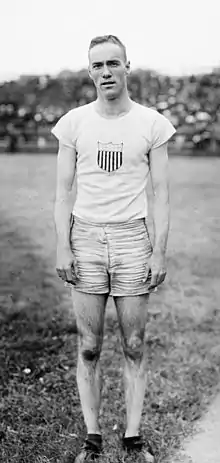Harold Barron
Harold Earl Barron (August 29, 1894 – October 5, 1978) was an American sprinter.[1] He specialized in the 110 m hurdles, in which he won a silver medal at the 1920 Summer Olympics.[2]
 Harold Barron at the 1920 Olympics | ||||||||||||
| Personal information | ||||||||||||
|---|---|---|---|---|---|---|---|---|---|---|---|---|
| Born | August 29, 1894 Berwyn, Pennsylvania, United States | |||||||||||
| Died | October 5, 1978 (aged 84) San Francisco, United States | |||||||||||
| Alma mater | Pennsylvania State University | |||||||||||
| Height | 1.83 m (6 ft 0 in) | |||||||||||
| Weight | 64 kg (141 lb) | |||||||||||
| Sport | ||||||||||||
| Sport | Athletics | |||||||||||
| Event(s) | 110 m hurdles | |||||||||||
| Club | Meadowbrook Club, Philadelphia | |||||||||||
| Achievements and titles | ||||||||||||
| Personal best(s) | 120 ydH – 15.0 (1917) | |||||||||||
Medal record
| ||||||||||||
Nationally Barron won the AAU hurdles title in 1917 and 1920 and the NCAA title in 1922. After graduating from Pennsylvania State University he worked as an athletics coach at Mercersburg Academy, then Cascadilla School in New York, and finally at Georgia Institute of Technology.[2]
In 1930 Barron, along with Earl Thomson and Harry Hillman, was involved in the design of a new safer hurdle, with a view to reducing the danger of bad falls and injuries.[3]
References
Wikimedia Commons has media related to Harold Barron.
- "Harold Barron". Olympedia. Retrieved July 15, 2021.
- Harold Barron. sports-reference.com
- Coaches Design New Track Hurdle to Prevent Falls, Alton Evening Telegraph, July 8, 1930
This article is issued from Wikipedia. The text is licensed under Creative Commons - Attribution - Sharealike. Additional terms may apply for the media files.
